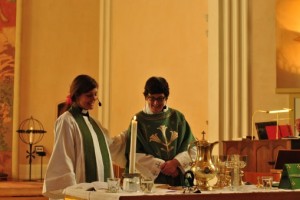Läs Anna Karin Hammars krönika på Dagens Seglora
Fördjupa dialogen om kristen tro
”Språket är beroende av relation och kommunikation, kommunikation på bristningsgränsen, som Bengt Kristensson Uggla uttrycker det. Språket ger inte direktkontakt med ”verkligheten” utan är en tolkning av denna ”verklighet”.”
”I samtalet mellan olika teologiska tolkningar finns det ett uttryck som återkommande upprepas, nämligen ”klassisk kristen tro”. Även om det sällan definieras är det ett uttryck för att vi äntligen håller på att få till ett rejält teologiskt samtal i den svenska ekumeniska rörelsen.”
// Irène
PS Vill också lyfta fram Ewa Lindqvist Hotz lysande avskedspredikan 27 oktober i Sofia församling ”om visioner för kyrkan och samhället, om en strandens teologi, i öppenhetens landskap, om den stafettpinne som hon och Seglora smedja har att förvalta. Här publiceras predikan i omarbetad version.”



Irène,
Den svenska teologiska dialogen är inlemmad i den internationella ekumeniska rörelsen. Kyrkornas Världsråd publicerade den 6 mars 2013 dokumentet: ”The Church: Towards a Common Vision”. Sådana här dokument riskerar att bli till intetsägande fraser, men man kan ibland upptäcka att den världsvida kyrkan har mer gemensamt än man förmodar:
“Unity is a gift of life and a gift of love, not a principle of unanimity or unilateralism. We have a calling as a fellowship of churches to express the unity of life that is given to us in Jesus Christ, through his life, cross and resurrection so that brokenness, sin, and evil can be overcome. For as The Church proclaims: ‘The kingdom of God, which Jesus preached by revealing the Word of God in parables and inaugurated by his mighty deeds, especially by the paschal mystery of his death and resurrection, is the final destiny of the whole universe. The Church was intended by God, not for its own sake, but to serve the divine plan for the transformation of the world’.”
“There is a growing consensus that koinonia, as communion with the Holy Trinity, is manifested in three interrelated ways: unity in faith, unity in sacramental life, and unity in service. The liturgy, especially the celebration of the eucharist, serves as a dynamic paradigm for what such koinonia looks like in the present age. St John Chrysostom spoke about two altars: one in the Church and the other among the poor, the suffering and those in distress. Strengthened and nourished by the liturgy, the Church must continue the life-giving mission of Christ in prophetic and compassionate ministry to the world and in struggle against every form of injustice and oppression, mistrust and conflict created by human beings.”
Läs hela dokumentet här:
http://www.oikoumene.org/en/resources/documents/wcc-commissions/faith-and-order-commission/i-unity-the-church-and-its-mission/the-church-towards-a-common-vision/@@download/file/The_Church_Towards_a_common_vision.pdf
Inez